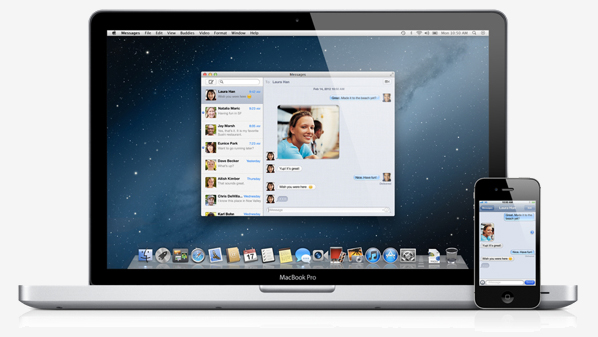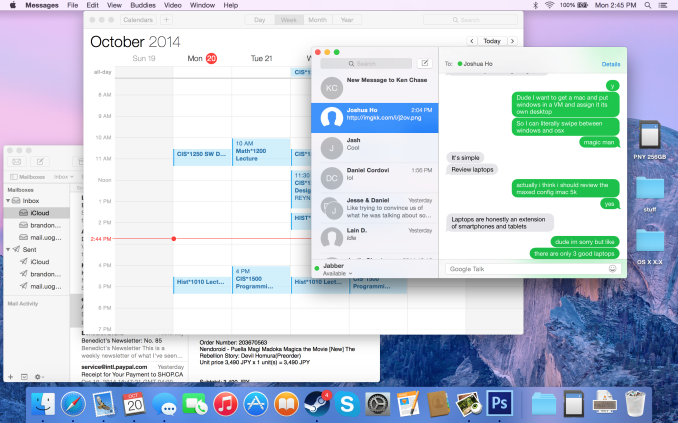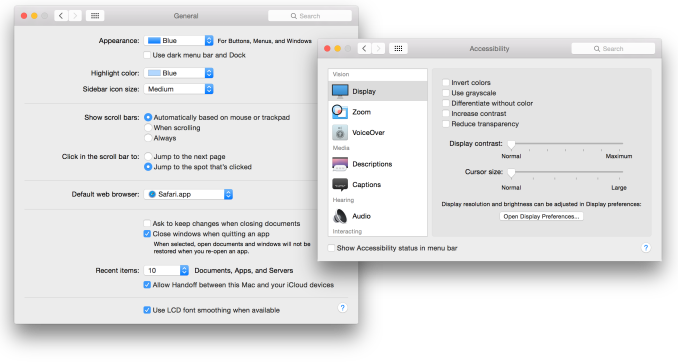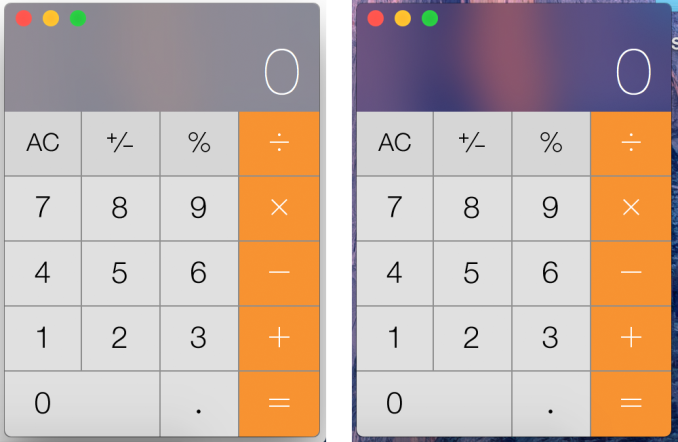A Look At OS X Yosemite And iOS 8.1
by Brandon Chester on October 27, 2014 8:00 AM ESTRethinking OS X
The original interface for iOS was inspired by Apple's Aqua UI, with skeuomorphic elements that mimicked real world objects. Computers have always mimicked the real world to a degree. They have buttons you press, and knobs you turn. The entire desktop metaphor is really just a digitization of the real world office with folders, documents, and a trash can. As computers have evolved and people have become more familiar with them, this overall metaphor has remained for the most part. But many of the visual elements that previously mimicked these real world objects could be simplified to copy in function, but not design. Users who are familiar with computers no longer need a distinct outline and heavy shading to recognize that a button is something they click or tap. They don't want their Calendar and Reminders applications to have leather borders, stitching, and paper like their calendar and date book in the real world, because doing so confines them to the limitations of those physical objects.
iOS 7 was in a sense a rebirth of iOS. The interface that had existed for six years was entirely redone. Core design elements like the homescreen remained, but everything was given a new visual style that eliminated skeuomorphism and ushered in a new era with a new design philosophy for Apple. This style of design is fairly well understood now. iOS makes heavy use of translucency and color. Each application has a primary color throughout which is indicated on its icon. Calendar uses red, Notes uses yellow, etc. With all these massive changes, the future of the design of OS X was uncertain.
One month after we got iOS 7, we got Mavericks. Mavericks was not the major overhaul that iOS 7 was. The visual elements of the operating system were very much the same as previous versions. This can simply be attributed to a lack of engineering resources. Apple's work to redesign iOS most certainly would have began after the departure of Scott Forstall which occurred after the release of iOS 6. Redesigning iOS in less than a year was quite an accomplishment, even with the bugs that were brought along with such a major change. It would have simply been impossible to do the same for OS X within the same period of time.
However, the design in Mavericks did not stand still. While the interface remained the same for the most part, many key applications that implemented skeuomorphic interfaces were redesigned. The leather and stitching was ripped out of apps like Calendar and Notes. The linen was removed from Notification Center and the login screen. These changes were the beginning of the path to what we have now with Yosemite.
For someone used to older versions of OS X, the above interface may seem like a shocking change. But for people who have been exposed to newer versions of iOS, it will actually feel quite familiar. The use of translucency, the flatter interface, and the new system font all draw upon the design principles that were established with iOS 7. It's important to understand what is meant by that. Apple is not establishing a common interface across their devices. OS X and iOS are not the same, and Apple has shown no interest in making them the same. What they are doing is using the same method of design, and the same type of interface elements, to create an experience across those two different operating systems that feels seamless and unified without having to compromise one to fit within the limitations of the other.
I was a fan of Apple's design direction with iOS 7, and so the same has held true for Yosemite. The use of translucency allows the customization of your wallpaper to have an impact on the appearance of the entire operating system. The status bar, the Dock, Launchpad, and any other window that uses translucency can look very different based on the wallpaper that is chosen. Using the new interface tends to have an interesting effect on the user by revealing how dated many parts of the older interface had become. Even users who enjoyed the older design will quickly find themselves questioning how they ever used such a dated interface. It's the same reaction I observed when the iOS userbase moved to iOS 7.
Usability and UI Performance
When the new design of Yosemite was revealed at WWDC 2014, some users voiced concerns that the new design would reduce clarity due to its lighter weighted fonts and heavy use of blur and transparency. On a typical 23" 1080p monitor I haven't noticed any issues reading text that uses the new system font which seems to be a modified Helvetica Neue, but I can see how it may be an issue on non-retina Macbooks where the viewing distance from the display is smaller than a desktop monitor. The blur is also well implemented to preserve legibility. Only the currently active window has the blur effects and transparency enabled. These sections turn opaque when a window is not being used, which means there are not layers upon layers of blur making it difficult to read any text on top of it.
For those who do find that some of the new design choices affect their ability to read or see things, Apple does provide a number of options for accessibility and visual customization. New additions include "Reduce transparency" which removes the translucency effects across the OS, and "Use dark menu bar and Dock" changes the white translucent material in the status bar, the Dock, and Spotlight Search to a black translucent material similar to Notification Center. I tried using the dark mode but I quickly reverted to the original design because the dark menu bar and Dock looked out of place amongst all the white and grey in the rest of the interface.
One issue I have observed with the blur is that windows will show the desktop wallpaper in addition to the applications between which should be blocking the wallpaper from showing through. As you can see above, despite me putting a completely opaque white box behind the calculator, there is still an area with an orange tint in the center. Removing the white reveals that the desktop has the same pattern. During the beta cycle the transparency would only display the wallpaper, and so there was a fix implemented but it introduced a problem of its own. I have seen complaints from other users about this issue, so hopefully it will be remedied in an upcoming update.
Performance is another area of concern with a new design and graphically demanding visual effects like translucency. I have noticed decreases in UI framerate compared to OS X Mavericks based on measurements with Quartz Debug. Overall the OS runs fairly well, but I would be lying if I said it didn't have its issues. Some scrolling lists will regularly drop to somewhere between 30 and 40fps. Scrolling performance in Notification Center is inconsistent, with performance closer to 60fps at some times, and closer to 30fps at others. The worst case I have encountered is the animation for Mission Control which has dropped as low as 5fps when many applications are open. Going forward it will be interesting to see how quickly and to what degree these issues are fixed by Apple.














173 Comments
View All Comments
p_giguere1 - Monday, October 27, 2014 - link
Apple offers the max RAM the motherboard can support (16GB) at purchase.The only reason you might want to upgrade RAM yourself is to buy the 8GB RAM model only to tell yourself "I'll upgrade to 16GB down the road when RAM gets cheaper". You might save something like $100 by doing that as opposed to ordering 16GB RAM right away.
So essentially, what you're complaining about is the equivalent of "The 13" rMBP is $100 to expensive for me", correct? Would you not complain if the price dropped $100? Not only would it be equivalent financially, but you'd benefit from 16GB RAM right away and wouldn't have to deal with the RAM upgrade process. Or is this more of a matter of principle?
Cheesetogo - Monday, October 27, 2014 - link
Apple does not charge market value for RAM.ant1pathy - Tuesday, October 28, 2014 - link
Nor do they for the raw aluminum that the frame is made of. No company charges market value for their materials, that's what makes them a company.name99 - Monday, October 27, 2014 - link
Enter a coherent argument, not a random series of rants.Are you upset with every phone vendor because they solder their RAM? Are you angry that you can no longer change the tubes in your TV set? Are you livid that you can't open a Chromecast and change the flash storage?
The fact that people could change their RAM on PCs was a weird temporary anomaly of the PC world; it will go away because of the inevitable laws of physics, just like the ability to change your FPU has gone away and the ability to change your GPU will go away soon. Soldered RAM uses less power (relevant today) and can be run at higher frequencies (relevant tomorrow). What Apple is doing will be done by every vendor in three years because physics demands it.
LostAlone - Tuesday, October 28, 2014 - link
But soldered components are blatantly anti-consumer. The ability to change units is not just for power users who like to upgrade, it's critical for being able to service units. Things break sometimes, and being able to fix that yourself is pretty important. How would you feel if your car needed you to call a qualified Honda technician to change a flat tire?And no, the ability switch around components is not just a temporary thing. That is how systems exist and have done literally since the dawn of the personal computer. The first generation of home computers were sold as kits that you physically had to assemble yourself, chip by chip.
Ever since then ever generation of hardware has been built around interoperability and upgrading. The only places where you get soldered on CPUs in the PC market is in embedded systems and similar super-low powered systems like many Atom boards that come with the CPU attached. In every other non-mac system you can swap out parts.
Look at standards like SATA and PCI-Express - They exist specifically so end users can expand a barebones system over time; add a USB 3.0 card or an SSD hard-drive to an aging machine to extend it's life, or add a RAID card and totally repurpose the system into a server. These are important choices. The ability to do more with your hardware than just what it was capable of doing in the box is central to what being a PC user is. You can do more. I still use my ten year old PC as my headless network file server, because I can, because I have the option to do that.
So no, fixing your own PC isn't going anywhere, nor is upgrading. Sorry. Not happening. I cannot imagine why you would think otherwise. Just because Apple does something doesn't make it a good thing, and scrabbling around to find reasons to justify it when in fact what they are doing is flipping consumers the bird and declaring that they don't think you are smart enough to fix something yourself.
Ever since Apple gave up and OSX became just a different operating system running on stock PC hardware they have been trying anything to convince people that they are somehow getting something magically better, even though it's literally the exact same hardware. The fact that they STILL refuse to sell the OS separate to the hardware, even when that hardware is just normal every day PC components that they have assaulted with a soldering iron, is just wrong. It's part of a brand image that still relies on a lot of good will from the days when Macs actually were something different. Well, they aren't. And most users would be radically better of installing OSX onto another manufacturers PC.
The way that Apple handles their desktop and laptop exo system sucks. Don't apologize for them.
ex2bot - Tuesday, October 28, 2014 - link
Whatever your platform of choice (esp. Apple), itis inadequate and ill-advised. Thus I urge, nay, command you to immediately adopt my preferred platform as the obvious technically and morally superior choice. I'll be watching.You have been warned.
sunnohh - Friday, October 31, 2014 - link
12 years as a computer tech and I left to become a stock broker because I could very clearly see that everything should be soldered onto a single component. It's physically faster, tremendously increases reliability (no ram and cpu to unseat), and makes business sense for Apple or anyone serious about making money selling hardware. The industry is moving away from add on tointegrated components Apple isn't the only one: virtually every major manufacturers hi end ultra books are built exactly this way.As computers get faster and more integrated, replace and throw away is the only valid model. Upgrading hardware is nothing more than sentimental; replacing hardware is more economical.
We live in a throw away culture and computing is the ultimate disposable; mores law necessitates this.
Just ask component manufacturers they'll tell you this is happening; their sales prove it.
Buk Lau - Wednesday, October 29, 2014 - link
phones have soldered ram because of form factor. you really think you can fit a SO-DIMM slot inside a case that's less than a quarter of an inch? where did you get the fact that soldered RAM uses less power and can run at higher frequencies? so you are saying your soldered ram can beat 3000mhz DIMM ram? your "physics" seems very out of placemonopodman - Wednesday, October 29, 2014 - link
It's funny because I consider retina MBP one of the first Apple laptops actually worth buying compared to top competitors even regardless of OS X vs. Windows.... I'm totally fine with 16gb of RAM (and I don't care if it's soldered as long as it makes motherboard smaller due to easier routing) or built-in battery (I'd rather have one with higher capacity fit into a smaller and lighter enclosure).appliance5000 - Friday, October 31, 2014 - link
dunno - running an entire heavy graphic oriented system of an 11" air - faster than the old mac pro. Pretty amazing - though I agree regarding difficulty in upgrading -what's acceptable with a laptop is not so much with a desktop.On the other hand the new macpro is a beast and you can add stuff to it to your heart's delight.